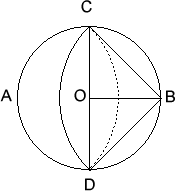Copyright © University of Cambridge. All rights reserved.
'Eyelids' printed from https://nrich.maths.org/
Show menu
Let $O$ be the centre of the circle and let the points where the arcs meet be $C$ and $D$ respectively. $ABCD$ is a square since its sides are all equal to the radius of the arc $CD$ and $\angle ACB=90^{\circ}$ (angle in a semicircle).
In triangle $OCB$, $CB^2 = OC^2 + OB^2$; hence $CB=\sqrt{2}$ cm. The area of the segment bounded by arc $CD$ and diameter $CD$ is equal to the area of section $BCD - $ the area of the triangle $BCD$, i.e.
$$\left(\frac{1}{4}\pi\left(\sqrt{2}\right)^2-\frac{1}{2}\times\sqrt{2}\times \sqrt{2}\right)\textrm{cm}^2$$,i.e. $(\frac{1}{2}\pi - 1)$ cm$^2$.
The unshaded area in the original figure is, therefore, $(\pi-2)$ cm$^2$. Now the area of the circle is $\pi$ cm$^2$, and hence the shaded area is 2 cm$^2$.

This problem is taken from the UKMT Mathematical Challenges.
You can find more short problems, arranged by curriculum topic, in our short problems collection.